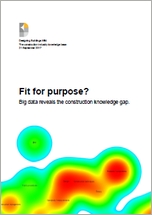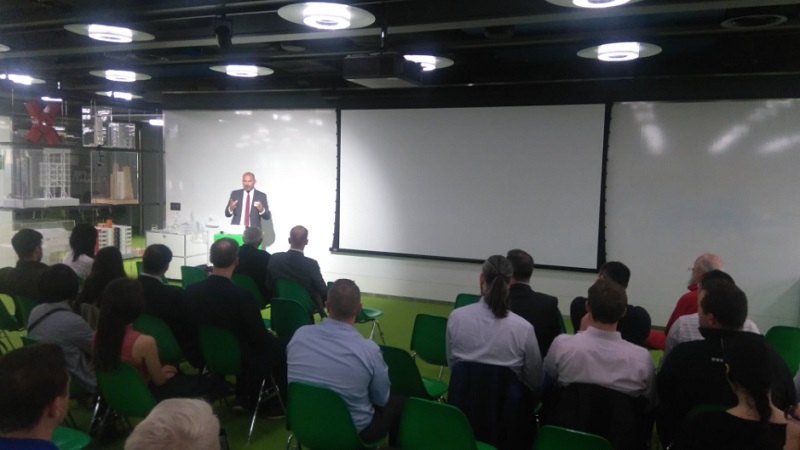Fit for Purpose launch event
See also: Construction knowledge gap meeting and Knowledge gap survey responses.
On 21 September 2017, Designing Buildings Wiki held an event to launch a new report 'Fit for purpose?' exposing a worrying and widening knowledge gap in the construction industry.
Held in the spectacular 14th floor offices of Rogers Stirk Harbour + Partners in the Leadenhall Building, the report asks whether the construction knowledge base needs to change if it is to serve the industry properly.
Following an introduction by Designing Buildings Wiki chairman David Trench, Mark Farmer, the author of the government-commissioned report ‘Modernise or Die’, drew some parallels between the dramatic findings of his own report and the entrenched problems revealed by 'Fit for purpose'.
Farmer said:
“The findings of this report reaffirm that current knowledge and innovation is not being captured in a way that is broadly and strategically accessible to enable industry at large to benefit. Knowledge and data ‘silos’ are a feature of our industry and we clearly need to break these open through more collaborative forums and platforms that have greater reach into the mainstream of our industry.
“The assertion that much academic work is not influencing industry’s improvement is one that I identify with and we need a step up in the vetting of what research is commissioned that has sufficient applied value for the wider industry rather than specialist interest groups that does not necessarily make it relevant or scalable.”
Dr Gregor Harvie, co-founder of Designing Buildings Wiki, then took the audience through the ‘Fit for Purpose?’ report, laying out with stark clarity the exponential increase in the amount of knowledge the industry has to process and the accelerating rate at which knowledge changes.
He then showed a series of visual heat maps, based on 6 million pieces of data accumulated from users of Designing Buildings Wiki, which illustrate as never before that the knowledge framework underpinning the construction industry is no longer fit for purpose. Practitioners do not have easy access to the critical knowledge they need, and research is not having an impact on the ground - so it is inevitable that mistakes will be made.
“Knowledge buried in long documents or behind paywalls”, Dr Harvie said, “will not be used, even if it’s important.”
The report makes clear that industry's knowledge creators continue to focus on niche research aimed at making the top performing 1% of the industry better. But it is leaving the other 99% to fend for themselves.
The never-before-seen heat maps reveal the vast difference between the knowledge the industry wants and the knowledge that is actually on offer. They also show differences in knowledge consumption between the sexes and between age groups, and this information could be used to created targeted knowledge, for example, to encourage younger women to remain in the industry.
Dr Harvie went on to explain that the average dwell time across all types of knowledge is just three minutes, with users increasingly accessing content on mobile devices. He suggested that if knowledge is not easily accessible, easy to apply, and free, the igeneration simply won't use it.
Highlighting the seriousness of the knowledge problem, Dr Harvie said:
“In the wake of the Edinburgh schools defects and the fallout from the Grenfell Tower tragedy, the report suggests the industry needs to get organised and stop leaving the dissemination of knowledge to chance - or more mistakes will be made.”
He proposed that the industry must co-ordinate to tackle knowledge as a whole, rather than piecemeal, and that new funding mechanisms are necessary to reward practitioners for contributing to the industry knowledge base, rather than just professional researchers.
To read more about the findings of the report and to download a copy, see Fit for Purpose?
Watch Gregor Harvie talking at the launch event.
Watch Mark Farmer talking at the launch event.
[edit] Designing Buildings Wiki would like to thank all those who attended the event and our sponsors Rogers Stirk Harbour + Partners for generously hosting us in their offices.
Featured articles and news
Latest Build UK Building Safety Regime explainer published
Key elements in one short, now updated document.
UKGBC launch the UK Climate Resilience Roadmap
First guidance of its kind on direct climate impacts for the built environment and how it can adapt.
CLC Health, Safety and Wellbeing Strategy 2025
Launched by the Minister for Industry to look at fatalities on site, improving mental health and other issues.
One of the most impressive Victorian architects. Book review.
Common Assessment Standard now with building safety
New CAS update now includes mandatory building safety questions.
RTPI leader to become new CIOB Chief Executive Officer
Dr Victoria Hills MRTPI, FICE to take over after Caroline Gumble’s departure.
Social and affordable housing, a long term plan for delivery
The “Delivering a Decade of Renewal for Social and Affordable Housing” strategy sets out future path.
A change to adoptive architecture
Effects of global weather warming on architectural detailing, material choice and human interaction.
The proposed publicly owned and backed subsidiary of Homes England, to facilitate new homes.
How big is the problem and what can we do to mitigate the effects?
Overheating guidance and tools for building designers
A number of cool guides to help with the heat.
The UK's Modern Industrial Strategy: A 10 year plan
Previous consultation criticism, current key elements and general support with some persisting reservations.
Building Safety Regulator reforms
New roles, new staff and a new fast track service pave the way for a single construction regulator.
Architectural Technologist CPDs and Communications
CIAT CPD… and how you can do it!
Cooling centres and cool spaces
Managing extreme heat in cities by directing the public to places for heat stress relief and water sources.
Winter gardens: A brief history and warm variations
Extending the season with glass in different forms and terms.
Restoring Great Yarmouth's Winter Gardens
Transforming one of the least sustainable constructions imaginable.































Comments
Really interesting research!